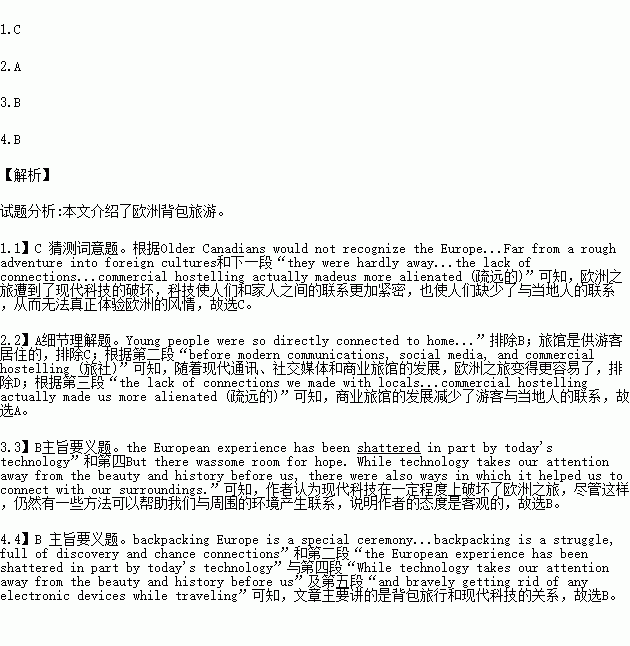题目内容
For Canadians, backpacking Europe is a special ceremony signifying a new life stage. Unlike package tours, backpacking is a struggle, full of discovery and chance connections. It is about focusing on something different from our own lives and losing ourselves in a new world, if only for a moment.
Well, that's what backpacking Europe is supposed to do. That’s what it used to do before modern communications, social media, and commercial hostelling (旅社). Older Canadians would not recognize the Europe that they backpacked in the 1960s, 1970s and even the 1980s. Far from a rough adventure into foreign cultures, the European experience has been shattered in part by today's technology.
A few years ago, I took my then 60-year-old father on a backpacking trip across part of Europe and Turkey. As he is an experienced traveler and someone who possesses a strong sense of adventure, I decided that we'd travel on a budget, staying in hostel dorms. For him, backpacking through Europe in 1969 was about independence and struggle. But two things surprised him at the end of our journey. First was how technology-based backpacking had become: Young people were so directly connected to home that they were hardly away in any meaningful sense. Second, the lack of connections we made with locals. Instead of making us feel closer to a place, he found commercial hostelling actually made us more alienated (疏远的).
But there was some room for hope. While technology takes our attention away from the beauty and history before us, there were also ways in which it helped us to connect with our surroundings. Websites like Airbnb have made it easier to stay with enthusiastic locals. Couch Surfing helps organize meet-ups between locals and travelers. The online marketplace Dopios offers a chance to meet locals through enjoyable experiences like a personalized city tour.
Backpacking can never be the way it was for our parents’ generation. But doing a little study of history and culture before leaving, and bravely getting rid of any electronic devices while traveling, will help give young travelers a taste of the glory days.
1.The underlined word “shattered” in Paragraph 2 most probably means ________.
A. broadened B. relived C. ruined D. acquired
2.After the recent backpacking trip in Europe, the author’s father finds ________.
A. backpackers connect less with locals than before
B. young people dislike getting in touch with their family
C. a hostel is a nice place for travelers to meet each other
D. backpacking in Europe becomes more difficult than before
3.What’s the author’s attitude towards technology?
A. Negative. B. Objective.
C. Uncertain. D. Uninterested.
4. The text mainly discusses the relationship between ________.
A. adventures and cultures
B. technology and traveling
C. young people and their family
D. Canadian travelers and Europeans

